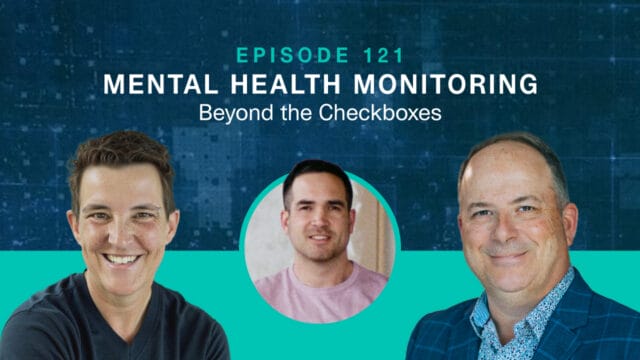
Holiday Bonus Episode: Safety Tips You Need This Season | Risk Matrix Episode 122
THE RISK MATRIX Cutting-edge podcast on occupational safety and risk management. Hosted by industry titans: JAMES JUNKIN, MS, CSP, MSP,…

The landscape of workplace safety is undergoing a radical transformation, driven primarily by cutting-edge technological advancements. From predictive analytics enhancing safety planning to adopting artificial intelligence in real-time monitoring, companies are integrating new safety measures into their process.
At this time of year, it’s all about planning, and we can’t help but think about 2024 predictions. Therefore, we break down the top 7 safety innovations you can incorporate into your strategy to help you become a safer company to work for.
Technological advancements are at the forefront of safety innovation as we think about 2024 predictions. Technology is transforming the workplace from wearable sensors to customized, interactive training tools to make it safer and more efficient.
Some examples of new technologies include:
Wearable Technology
Smart devices like connected wristbands and helmets enable companies to be more proactive in their safety processes by monitoring various health metrics to detect warning signs that employees and management should be aware of, such as:
Artificial Intelligence (AI)
While the accessibility and magic of ChatGPT make AI seem like a recent innovation, AI isn’t new at all. In fact, its origin traces back to the 1950’s. But over several decades, AI has become smarter, enabling computer programs to make decisions based on repetitive, similar experiences.
That’s where predictive analytics comes in. Some contractor software companies offer predictive capabilities that help you make safety decisions based on leading indicators.
Impairment Testing
2024 predictions wouldn’t be complete without including the enhancement of existing tools. Impairment testing allows companies to test for other factors that can negatively affect job performance, taking traditional drug and alcohol testing to a new level. Countless factors can affect worksite performance, and companies must see the whole picture to avoid potentially deadly consequences in high-hazard environments.
Those factors include but are not limited to the following:
Innovations in Training
With so many young people entering the trades, companies must adapt their training programs to meet this group where they are. Younger workers are more tech-savvy and have grown up surrounded by digital technology. They’re more responsive to training methods that include interactive technology, such as virtual reality (VR), to make training more effective and engaging.
In addition to having wearable technology integrated into PPE, companies are recognizing the importance of comfort. Gone are the days of a “one size fits all” approach. Companies have learned that PPE effectiveness is only as good as the fit and, since workers come in all shapes and sizes, it needs to be as customizable as possible.
Watch for these two 2024 predictions for PPE trends:
Personal Preference
Workers perform better when they are comfortable with their PPE. That means you need to consider personal preference when fitting people for equipment.
For example, unless you have a “no beards” policy at your workplace, you must consider facial hair when fitting respirators. OSHA regulations require that the respirator forms a seal on the worker’s face to be effective. A beard can interfere with that seal, so companies may find alternative PPE that does not require a face seal, such as a powered air-purifying respirator.
Bigger Emphasis on Fit
Have you ever had a worker show up to a job site and forget their safety shoes? It’s tempting for them to take a spare pair half a size too big “just for today.”
It might seem insignificant, but poorly-fitting shoes increase their risk of accidents like trips and falls. And did you know ill-fitting PPE can result in a lack of use by employees? Not only does this expose workers to safety risks, but it also leads to non-compliance for the overall company.
Emphasizing a proper PPE fit is a crucial step in protecting all workers.
Another positive trend in the workplace and part of our 2024 predictions is heightened awareness of workers’ mental health. According to new research, as many as a third of UK construction workers (and 83% of US workers) have suffered from mental health problems – potentially leading to the following:
Employers are increasingly recognizing the importance of mental health in the workplace and are taking significant steps to prioritize it. Namely, safety culture has a direct link to mental health. If workers do not feel safe consistently on the job site, it can easily affect their mental health and well-being.
These invisible but dangerous symptoms can lead to missed days, which poses a risk of missing project deadlines. Safety culture should be integrated into every level of an organization, prioritizing the well-being of workers and ensuring they go home safely every day.
Other steps companies are taking to prioritize mental health are implementing employee health and wellness programs and promoting a healthy work-life balance.
2024 predictions for ESG have an overarching theme of “transparency, accountability, and the integration of ESG practices into business strategies.”
ESG is no longer an emerging idea. It’s rapidly evolving, and to comply with regulations and stakeholder expectations, you must ensure a sound strategy in place today, regardless of your ESG maturity.
These are some of the trends to watch for in the next year:
Transparency and Accountability
There is increased pressure from investors, employees, and communities for companies to be honest and transparent about their efforts to reduce emissions and environmental impact. This trend will continue and have an increased sense of urgency in 2024.
Mandatory Disclosures
We are already seeing increased pressure for companies to disclose their ESG efforts and make them public. For example, in 2024, the Canadian government will require certain companies to conduct comprehensive ESG reporting to reduce the risk of forced and child labor in Canadian supply chains.
Bill S-211 will be effective starting January 1, 2024, and 2023 reports are due May 31. In addition to submitting the report to the federal government, companies must make it available to the public, including by publishing it in a prominent place on its website.
Increased Scrutiny of Scope 3 Emissions
Now that business leaders have wrapped their heads around the significant impact of Scope 3 emissions on their total carbon footprint, it’s time to get serious about capturing and reporting data. Scope 3 emissions can significantly affect your overall sustainability profile, and Scope 3 rules are just around the corner.
2024 will also pressure companies to understand where their Scope 3 emissions come from throughout their supply chain. One of the biggest challenges with Scope 3 emissions is that your company needs oversight in controlling emissions.
Since these emissions are incurred throughout the entire supply chain, you must have the right tools to give you complete visibility into the metrics. Only then can you begin exploring Scope 3 emissions reduction opportunities, including hiring vendors with better ESG practices in place.
Fires, floods, and intense storms dominated the news in 2023, and 2024 predictions show these events may increase again due to many factors, including climate change. The best way for businesses to increase resilience to these unforeseen events is to be well prepared.
Here are some of the trends we’ll see over the following year to help businesses avoid disruptions and keep workers safe:
Advanced Fire Protection Systems
Wildfires were rampant in 2023; some were so massive that they affected air quality hundreds (and sometimes thousands) of miles away. With the rise of these types of disasters (some natural, some man-made), there is a growing emphasis for companies to protect their business and their workers by taking these steps:
Climate Resilience Strategies
According to FIMA’s 2022 National Preparedness Report, businesses are increasingly prioritizing climate resilience planning to mitigate the impacts of extreme weather events. This process involves assessing vulnerabilities, developing response plans, and investing in infrastructure to withstand climate-related hazards.
Risk Management Throughout the Supply Chain
Planning for a disaster doesn’t end within the walls of your business; it needs to extend to your supply chain. Supply chain disruptions can be catastrophic to your bottom line, so you must think beyond your immediate operations.
Mitigating supply chain risks may include the following steps:
IoT is the term for devices connected to other internet-ready machines, creating a network where people collect and share data. IoT has emerged as a transformative force in high-hazard industries, particularly equipment safety.
The process involves embedding sensors and smart devices into machinery and equipment, creating an interconnected ecosystem beyond functionality. Its capabilities extend to enhance safety measures on job sites.
IoT is also useful when sending out reminders to employees of any new safety policies that have come into play as they move from job to job, helping to keep different team members in the loop when doing their respective jobs safely and developing a positive culture around safety within the organization.
Performing frequent audits empowers management to keep their finger on the pulse when enforcing new safety policies. It also helps them understand where persistent safety gaps exist.
The benefits of regular safety audits are plentiful. They enable teams to determine how effective their health & safety procedures are and quickly implement changes to prevent incidents and keep workers safe from hazards.
Audits also present an opportunity to ensure workers engage with current health and safety practices by assessing their understanding of how safety influences specific tasks. By asking employees to provide feedback and insight on hazards, an audit paves the way for a proactive discussion that might otherwise not have happened. Having a third party conduct audits also ensures your team stays on top of OSHA, HSE, or Safe Work Australia regulations.
Software can streamline the auditing process by generating safety data into reports, helping to identify patterns, and addressing risks faster.
Workplace safety and innovation will be inextricably linked in 2024 and beyond. From training approaches to real-time monitoring, safe AND comfortable PPE, and planning for a worst-case scenario, now is the time to think differently about how you get your projects done safely and on time.
You don’t need 2024 predictions to know the well-being of workers is a top priority for all companies, and your investment in innovation and technology adoption should reflect those principles. Having the right partner can help you transform how you plan your safety strategy by offering solutions that make it easy. Allow Veriforce to help you leverage industry innovation and take your safety processes to the next level.
Contact us today to learn more.


THE RISK MATRIX Cutting-edge podcast on occupational safety and risk management. Hosted by industry titans: JAMES JUNKIN, MS, CSP, MSP,…

THE RISK MATRIX Cutting-edge podcast on occupational safety and risk management. Hosted by industry titans: JAMES JUNKIN, MS, CSP, MSP,…
We’ll send you practical and insightful supply chain risk management info that can benefit your business. Plus, important company updates that keep you in the loop.
